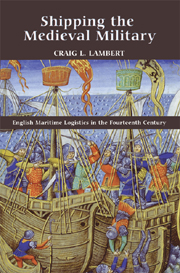Book contents
- Frontmatter
- Contents
- List of Tables
- Acknowledgments
- Abbreviations
- Introduction
- 1 Raising a Fleet
- 2 The Supply of Armies and Garrisons by Sea, 1320–1360
- 3 The Transportation of English Armies to France, 1324–1360
- 4 Maritime Resources and the King's War
- Conclusion
- Appendix 1 Ports that Supplied Ships to the Fleets
- Appendix 2 Reconstructing the Merchant Fleet: A Methodology
- Bibliography
- Index
- Warfare in History
3 - The Transportation of English Armies to France, 1324–1360
Published online by Cambridge University Press: 12 September 2012
- Frontmatter
- Contents
- List of Tables
- Acknowledgments
- Abbreviations
- Introduction
- 1 Raising a Fleet
- 2 The Supply of Armies and Garrisons by Sea, 1320–1360
- 3 The Transportation of English Armies to France, 1324–1360
- 4 Maritime Resources and the King's War
- Conclusion
- Appendix 1 Ports that Supplied Ships to the Fleets
- Appendix 2 Reconstructing the Merchant Fleet: A Methodology
- Bibliography
- Index
- Warfare in History
Summary
Preparing the Fleet: A Timetable for Invasion
In Chapter 1 the discussion centred on the underlying bureaucratic procedures employed by the clerks, and the varying methods available to the kings of the period, when it came to raising a fleet. It was found that Edward II and Edward III had nine methods that they could exploit to raise a supply or transport armada. But the analysis did not investigate the time-scale involved in these operations. In short, how long did the government take to assemble a feet of ships from the issue of the first requisition order to the arrival of the last vessel at the port of embarkation? This is, in fact, a complicated question to answer for two reasons. First, the size of the intended fleet had obvious implications for the length of time it would take to assemble it. Second, because the transport flotillas were raised in conjunction with the recruitment of the land-based forces, any delay in the latter would affect the former.
By examining four transport fleets between 1324 and 1359 it is possible to offer some broad conclusions on this question. The armadas in question are the St Sardos fleet, the 1338 Low Countries armada, the Crécy fleet and the Reims flotillas of 1359. These transport fleets provide a range of challenges to study. For example, the St Sardos campaign was the only significant expedition launched against France by Edward II, while the 1338 fleet was Edward III's first endeavour to the continent.
- Type
- Chapter
- Information
- Shipping the Medieval MilitaryEnglish Maritime Logistics in the Fourteenth Century, pp. 101 - 155Publisher: Boydell & BrewerPrint publication year: 2011



